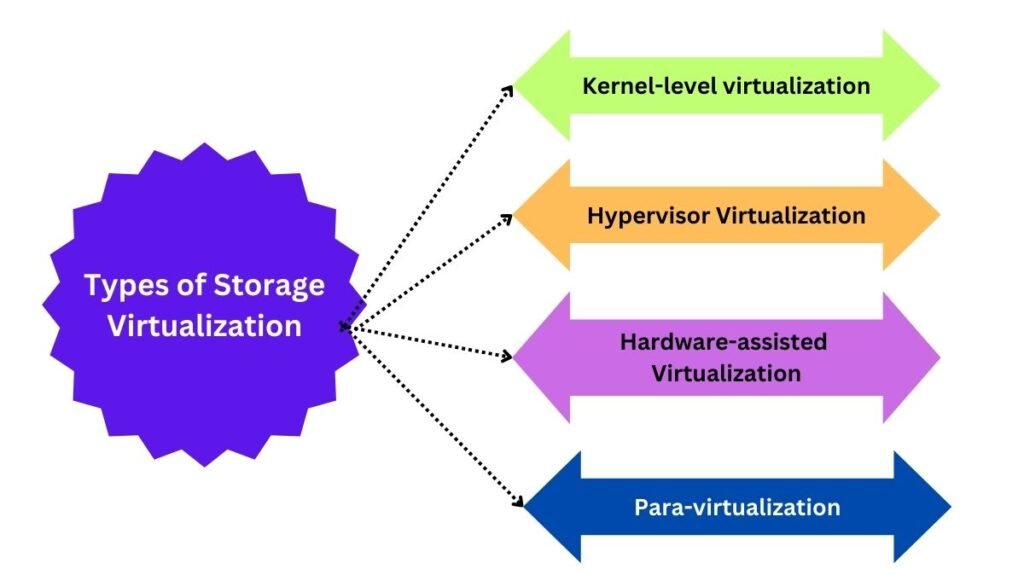What is Storage Virtualization?
Storage virtualization makes RAID levels and controllers, which are crucial parts of storage servers, appealing. The disks are directly accessible for writing by the device’s operating systems and applications. The controllers in RAID groups configure local storage, and the operating system views the storage according to the configuration. However, because the storage is abstracted, the controller must determine how to write or retrieve the data that the operating system requires.

Types of Storage Virtualization

Kernel-level virtualization
A separate Linux kernel version runs in hardware virtualization. The kernel level allows several servers to run on a single host.
Hypervisor Virtualization
A component called a hypervisor is installed in between the hardware and the operating system. It makes it possible for many operating systems to function efficiently.
Hardware-assisted Virtualization
This type of virtualization is comparable to full para-virtualization, but it requires hardware upkeep.
Para-virtualization
The hypervisor, which manages software emulation and trapping, is the cornerstone of para-virtualization.
Methods of Storage Virtualization
Network-based storage virtualization
Network-based storage virtualization is the most often utilized virtualization type in enterprises. A network device, such as a smart switch or specifically made server, connects all of the storage devices in an FC or iSCSI SAN. This device shows the network’s storage as a single virtual pool.
Host-based storage virtualization
Cloud storage and HCI systems are the two most common applications for host-based storage virtualization, which is software-based. Whether the guest machines are virtual machines (VMs) in an enterprise setting, physical servers, or PCs accessing file shares or cloud storage, the host, or a hyper-converged system composed of many hosts, provides virtual drives of different capacities to the guest machines in this sort of virtualization.
Array-based storage virtualization
Using arrays for storage The most common application of virtualization is when a storage array with virtualization software acts as the primary storage controller. This enables the array to display several physical storage types that can be utilized as storage tiers and to share storage resources with other arrays.
How Storage Virtualization Works?
- During storage virtualization, physical storage hardware is duplicated in a virtual volume.
- A basic virtual storage system is created by combining multiple physical discs into a grouping on a single server.
- A virtualization layer isolates the virtual volume from the physical discs, allowing operating systems and applications to access and utilize the storage.
- The physical discs are divided into groupings of small data blocks known as logical volumes (LV), logical unit numbers (LUNs), or RAID groups.
- In more complicated situations, RAID arrays can be used as virtual storage. Numerous physical drives mimic a single storage device that strips data and transfers it to multiple discs in the background.
- To access data from the actual CDs, the virtualization program must perform an additional step.
- Virtual storage can be created in both file-level and block-level storage settings.
Advantages of Storage Virtualization
A few Advantages of storage virtualization are listed below.
- The storage devices enable advanced capabilities including disaster recovery, replication, and redundancy.
- It makes it possible for everyone to create their own business opportunities.
- Data is stored in more convenient locations that are further away from the specific host. In the case of a host failure, the data is not necessarily compromised.
- By abstracting the storage layer, IT operations may now more easily provision, split, and secure storage.
Disadvantages of Storage Virtualization
Some Disadvantages of storage virtualization are listed below.
- There are some restrictions on storage virtualization that need to be taken into account.
- Data security remains an issue. Although some may argue that virtual computers and servers are more secure than physical ones, virtual environments can attract new kinds of cyberattacks.
- Storage virtualization implementation is not always simple. Scalability is one of the few technological challenges.
- Virtualization breaks the end-to-end view of your data. It is necessary to integrate the virtualized storage solution with the existing tools and systems.
Example of storage virtualization
Storage virtualization is the process of combining several physical drives into a group and allocating logical storage blocks or virtual storage to a server for use. The most basic types of storage virtualization objects include RAID groups, logical volumes (LV), logical unit numbers (LUNs), etc.
- Logic Unit Number (LUN): An illustration of virtualized storage
- Logical Volume (LV): A storage virtualization example
- RAID groups: An illustration of virtualized storage
- Storage arrays are used to manage storage resources and display them as a single virtual storage pool in array-based storage virtualization.
- One popular kind of storage virtualization that shows storage to a guest operating system is host-based storage virtualization.
- One kind of storage virtualization that eliminates the connection between the location of physical memory and the data being accessed is file-based storage virtualization.
In conclusion
The cloud paradigm has largely eclipsed storage virtualization, which it realized offered significant operational and financial benefits over “bare metal” storage. Businesses were able to reduce compatibility problems and increase the security and speed of storage systems by implementing virtualized storage.

